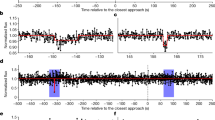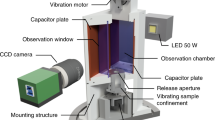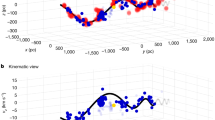Abstract
THE outer parts of Saturn's rings display a variety of local non-uniformities in their particle distributions. Azimuthal brightness variations are seen in the A-ring1,2, and may be attributable to the gravitational aggregation of particles into linear wakes that trail the rotation of the ring3–5; Voyager's stellar occultation experiments revealed large differences, on length scales as small as 150 m, in the surface density of particles6. Theoretical arguments7,8 suggest that local instabilities may occur in both the A-and B-rings, the instability criterion depending on the velocity dispersion of ring particles and the orbital velocity and mass density in the ring. These arguments, however, are derived from the purely gravitational dynamics of an idealized, infinitesimally thin ring, made of identical particles. Here I use numerical simulations, including both gravitational interactions and dissipative impacts between particles, to study realistic models of Saturn's rings. For the C-ring there is no instability, but for the B- and A-rings gravitational wakes form. In the A-ring these wakes are so strong that particles trapped in them form metre-sized aggregate particles, which themselves lead to further instability. These different behaviours are consistent with the observational evidence.
This is a preview of subscription content, access via your institution
Access options
Subscribe to this journal
Receive 51 print issues and online access
$199.00 per year
only $3.90 per issue
Buy this article
- Purchase on Springer Link
- Instant access to full article PDF
Prices may be subject to local taxes which are calculated during checkout
Similar content being viewed by others
References
Camichel, H. Ann. Astrophys. 21, 231–242 (1958).
Thompson, W. K., Lumme, K., Irwine, W., Baum, W. & Esposito, L. Icarus 46, 187–200 (1981).
Colombo, G., Goldreich, P. & Harris, A. W. Nature 264, 344–345 (1978).
Franklin, F. A. et al. Icarus 69, 280–296 (1987).
Dones, L. & Porco, C. Bull. Am. astr. Soc. 21 No. 3, 929 (1989).
Showalter, M. R. & Nicholson, P. D. Icarus 87, 285–306 (1990).
Goldreich, P. & Tremaine, S. A. Rev. Astr. Astrophys. 20, 249–283 (1982).
Salo, H. Earth Moon Planets 30, 113–128 (1984).
Bridges, F. G., Hatzes, A. P. & Lin, D. N. C. Nature 309, 333–335 (1984).
Toomre, A. Astrophys. J. 139, 1217–1238 (1964).
Wisdom, J. & Tremaine, S. Astr. J. 95, 925–940 (1988).
Salo, H. Icarus 90, 254–270 (1991).
Cuzzi, J. N., Burns, J. A., Durisen, R. H. & Hamill, P. Nature 281, 202–240 (1979).
Salo, H. Earth, Moon Planets 33, 189–200 (1985).
Salo, H. Earth, Moon Planets 38, 149–181 (1987).
Salo, H. Icarus, 96, 85–106 (1992).
Julian, W. H. & Toomre, A. Astrophys. J. 146, 810–830 (1966).
Weidenschilling, S. J., Chapman, C. R., Davis, D. R. & Greenberg, R. in Planetary Rings (eds Greenberg, R. & Brahic, A.) 367–415 (Univ. of Arizona Press, Tucson, 1984).
Sellwood, J. A. & Carlberg, R. G. Astrophys. J. 282, 61–74 (1984).
Toomre, A. in Dynamics and Interactions of Galaxies (ed. Wielen, R.) 292–303 (Springer, Berlin, 1990).
Zebker, H. A., Marouf, E. A. & Tyler, G. L. Icarus 64, 531–548 (1985).
Cuzzi, J. N. et al. in Planetary Rings (eds Greenberg, R. & Brahic, A.) 73–199 (Univ. of Arizona Press, Tucson, 1984).
Esposito, L. W. Bull. Am. astr. Soc. 10 No. 3, 584–585 (1978).
Franklin, F. A. & Colombo, G. Icarus 33, 279–287 (1978).
Author information
Authors and Affiliations
Rights and permissions
About this article
Cite this article
Salo, H. Gravitational wakes in Saturn's rings. Nature 359, 619–621 (1992). https://doi.org/10.1038/359619a0
Received:
Accepted:
Issue Date:
DOI: https://doi.org/10.1038/359619a0
This article is cited by
-
Spatial structure and coherent motion in dense planetary rings induced by self-gravitational instability
Earth, Planets and Space (2014)
-
The birth of Saturn's baby moons
Nature (2010)
-
Rapid planetesimal formation in turbulent circumstellar disks
Nature (2007)
-
Cassini Imaging Science: Instrument Characteristics And Anticipated Scientific Investigations At Saturn
Space Science Reviews (2004)
Comments
By submitting a comment you agree to abide by our Terms and Community Guidelines. If you find something abusive or that does not comply with our terms or guidelines please flag it as inappropriate.



